Review and photos by EmperorDinobot, edited by Suspsy
My fellow collectors, the future is now. The long-awaited first wave of ceratopsians from Beasts of the Mesozoic by Creative Beast Studios has arrived. There were some delays due to the unfortunate event that is the current pandemic, but our wait was worth it. These ceratopsians are absolutely glorious. Today I shall be telling you of the beauty that is Styracosaurus.
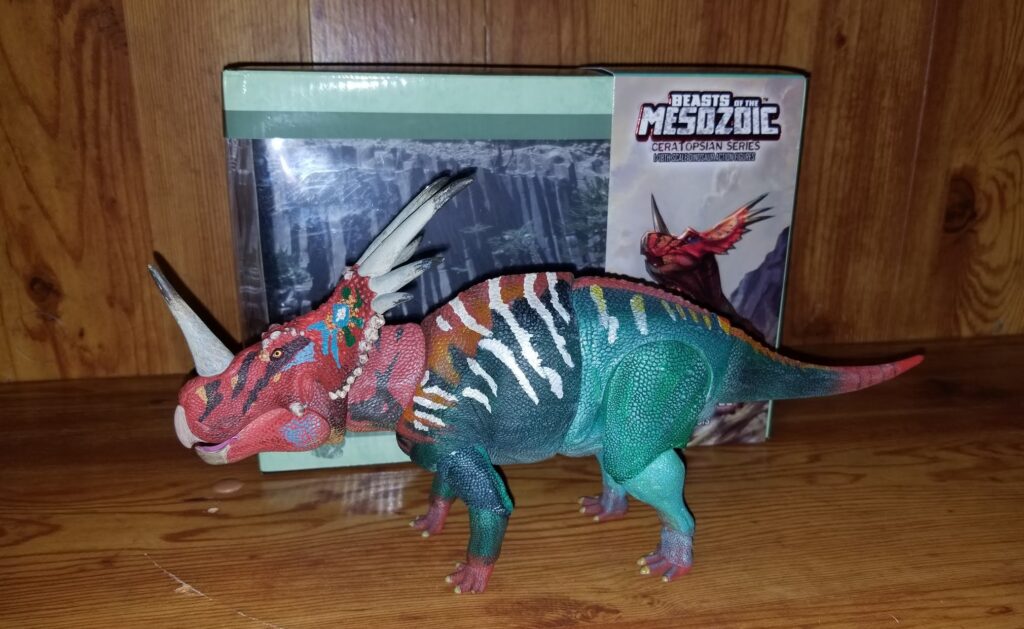
Glorious. Simply glorious.
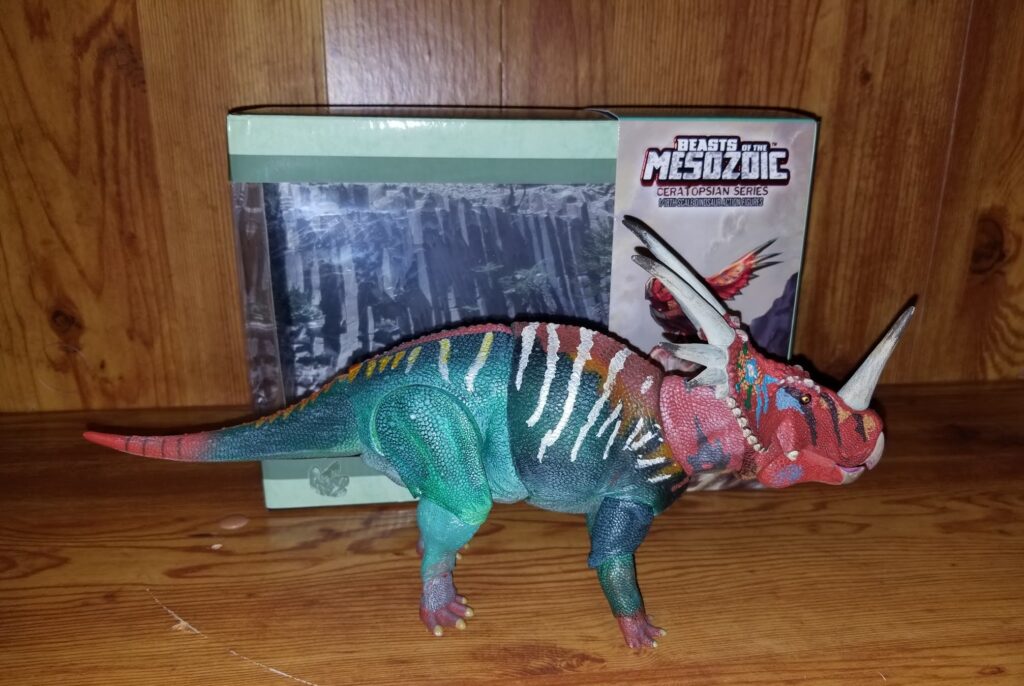
I was unprepared at how huge this figure is! I could calculate it by looking at the pictures on the official website, as I collect 3 3/4 to 4 inch tall figures, but once I got it in the mail, I was overwhelmed with how big the box was.

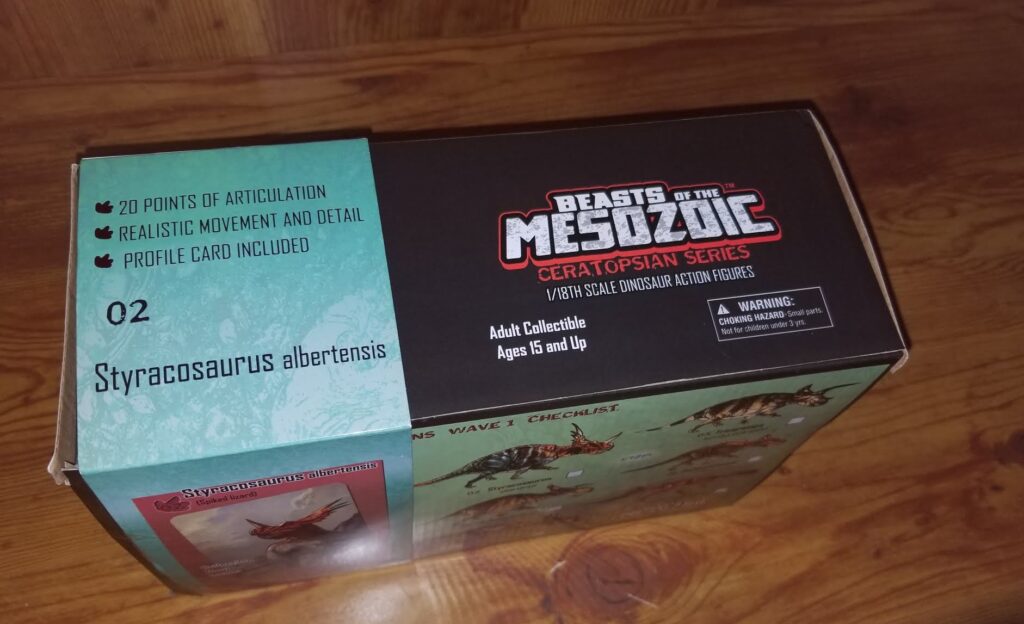

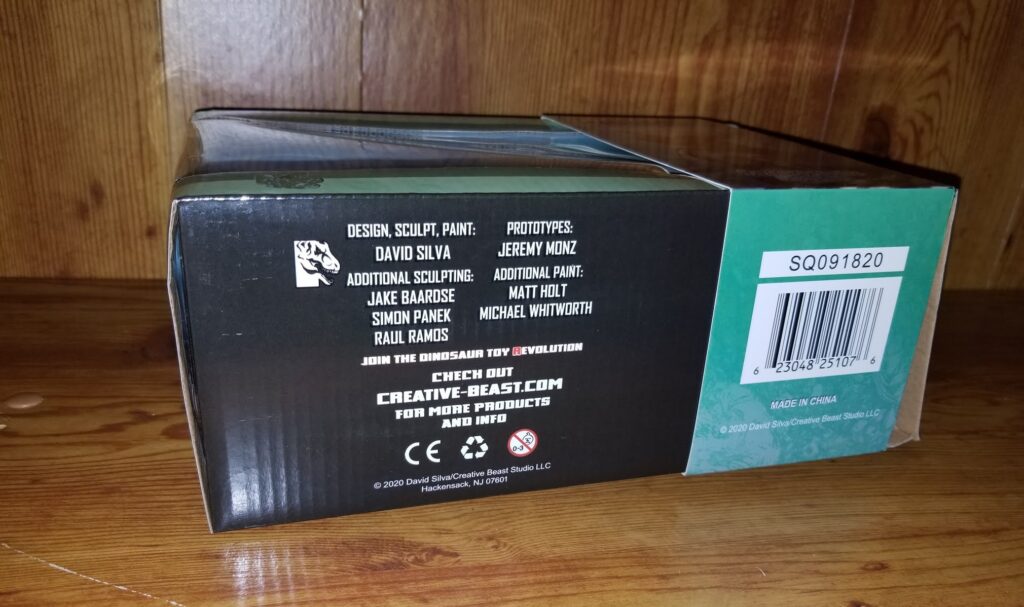
As with the previous raptors, the box is more or less the same design, with a bubble insert to hold the figure in, artwork on the back with a checklist of Wave 1 of this line, and a sleeve that features the art of Jax Jocson and Carlo Arellano.

The cardboard insert features a rocky cliff, again like the ones in the raptors line. It is quite nice to pose the Styracosaurus next to it.
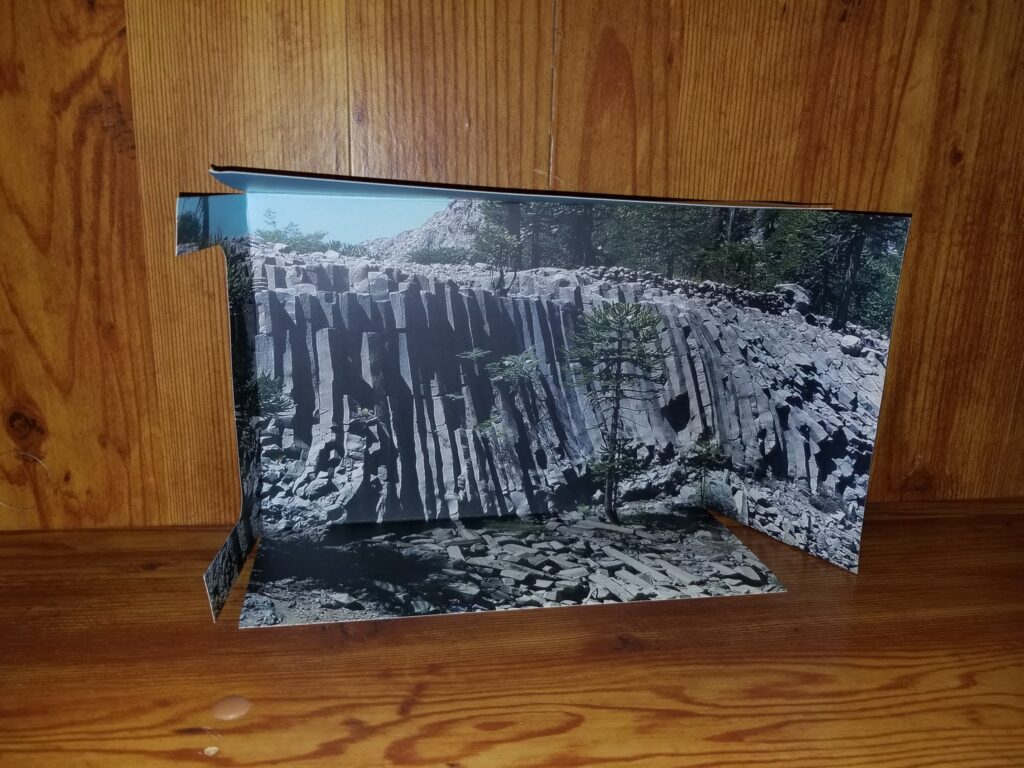
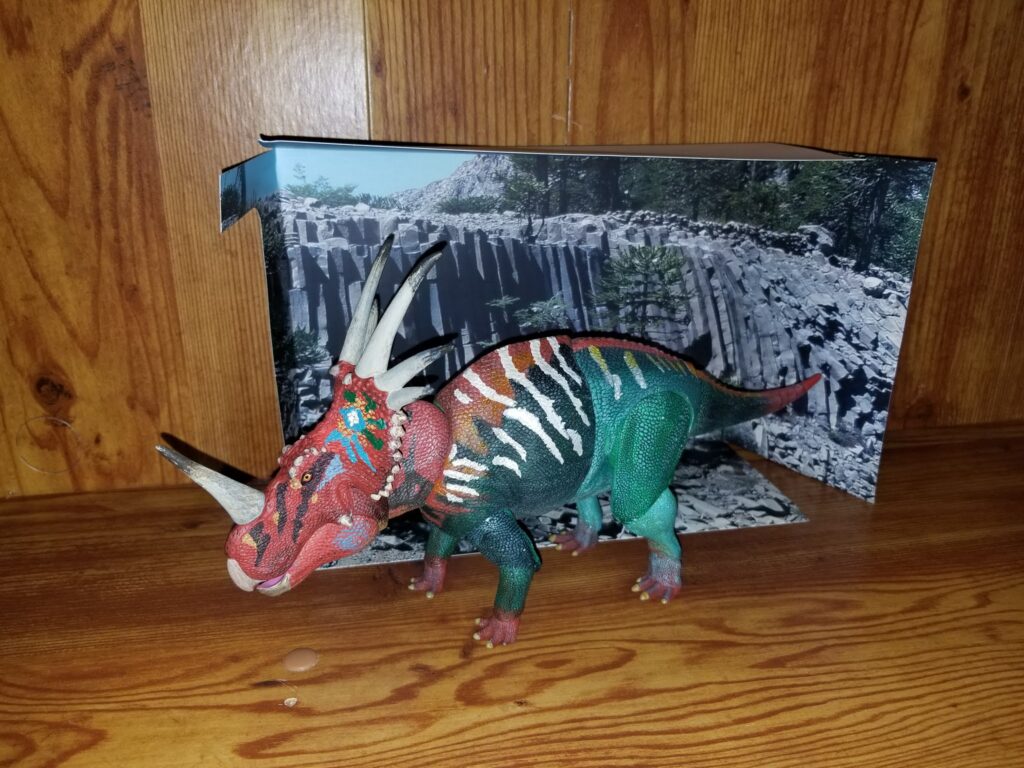
Inside the box, there’s a set of instructions telling you how to properly attach the tail piece. It states that you should warm up the tail before attaching it to the body, because it is quite tight and somewhat difficult to get it in at room temperature.
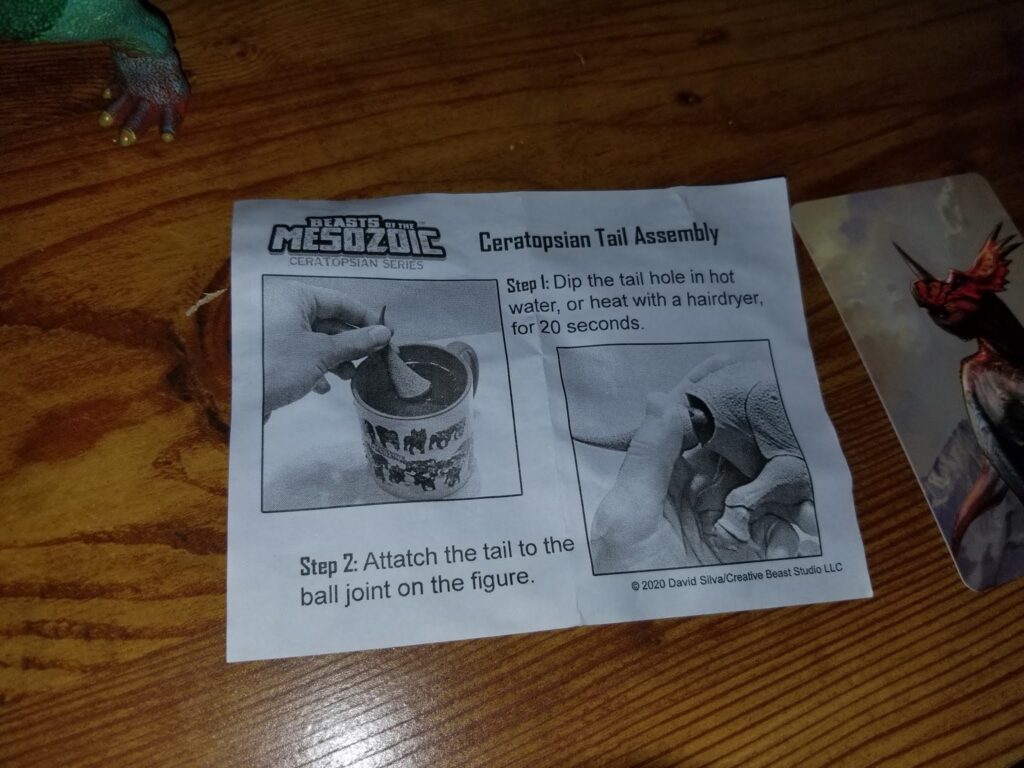
The back of the card states the following facts:
Name: Styracosaurus albertensis
Length: up to 5.5m (18ft) long
Location: Dinosaur Park Formation, Alberta, Canada
Time Period: Late Cretaceous 75 m.y.a.
Named by: Lawrence Lambe, 1913
Famously known for its six frill spikes and long nose horn, Styracosaurus is one of the most recognizable of all the ceratopsians. Despite its iconic look, similarities to Centrosaurus have caused debate in the past over which specimens belonged to each species.


Styracosaurus is my favorite ceratopsian along with Pachyrhinosaurus. This figure boasts 19 points of articulation, and it does not disappoint, as you shall see in the next few pictures. The color is based on the common green forest lizard. I absolutely love the colors of every figure from Beasts of the Mesozoic and have always appreciated how colorful they are and the fact that they are based on living animals. The idea to make ceratopsians quite colorful is very fresh, as artists in the past have portrayed them as rather dull–with the exception of James Gurney, I suppose. Remember the 80s and early 90s depictions of Styracosaurus with a dark blue body and a red head? I love it how they sort of kept this (well, the body is more green than it is aquamarine, but my camera’s flash makes it look really blue, my apologies) by using the forest lizard’s color scheme.
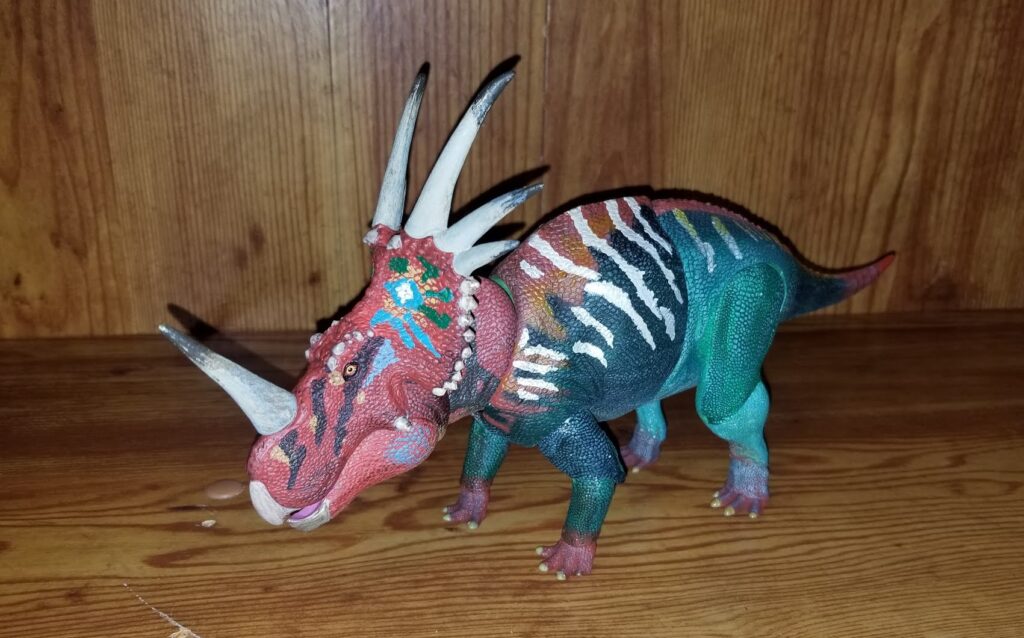
The head sculpt is really well done, and very brightly colored, with the frill spikes, nose horn, and hornlets being painted in a cool shade of gray with black highlights. It has a real natural feel to it.
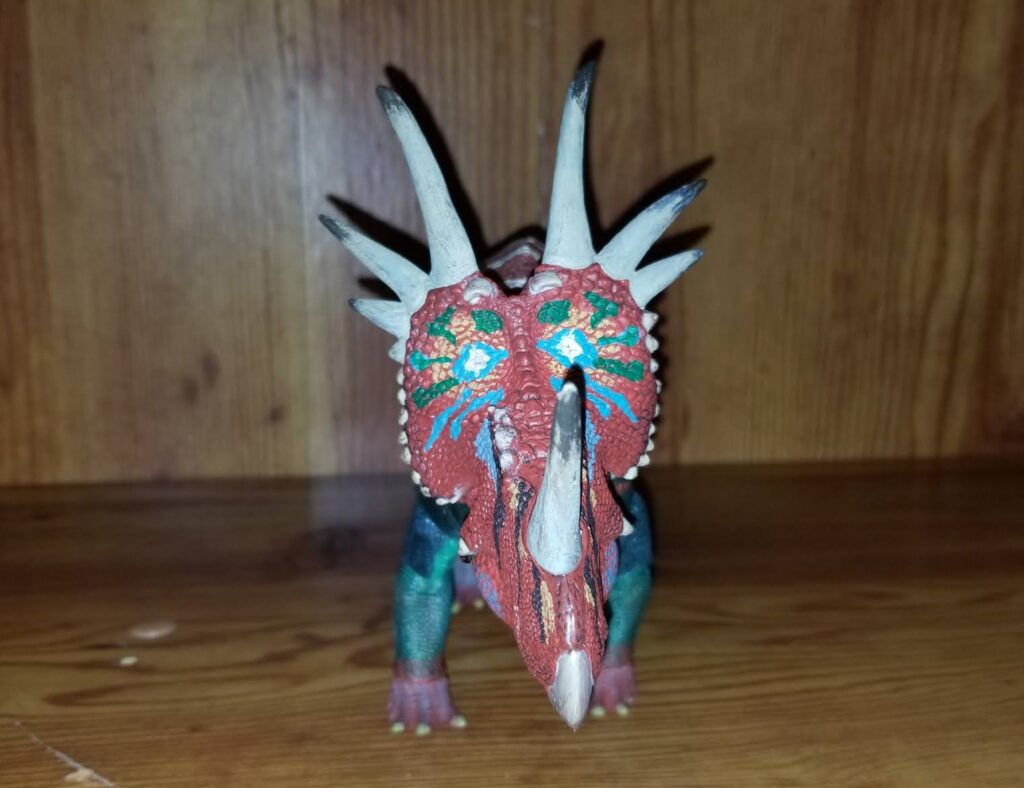
The body has cream-colored stripes with orange ones running through its hips and back. The end of the tail is red with four blue rings. For some reason, my camera makes it look like the back half of the animal is in a lighter green shade, but it’s more difficult to notice once it is in your hands. The sclera are yellow.
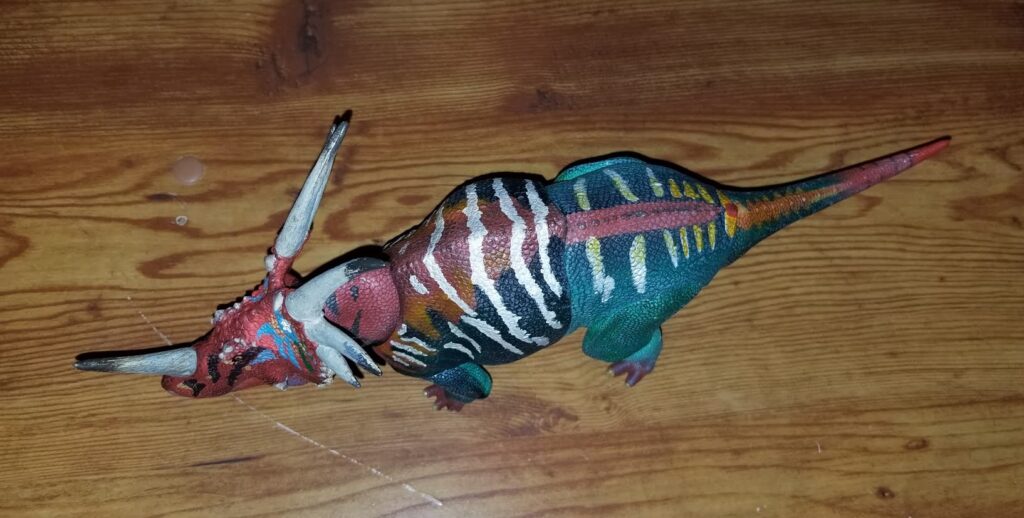
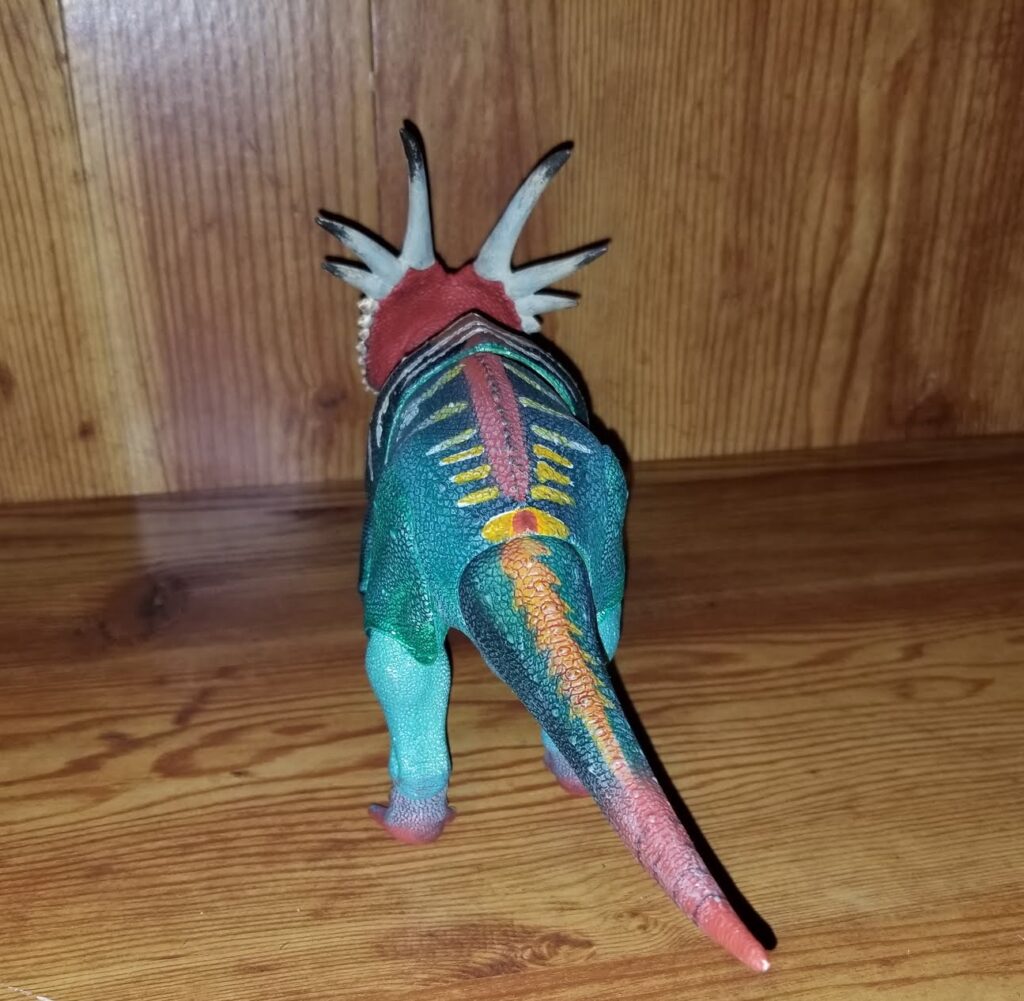
The feet are red and even detailed on the bottom.
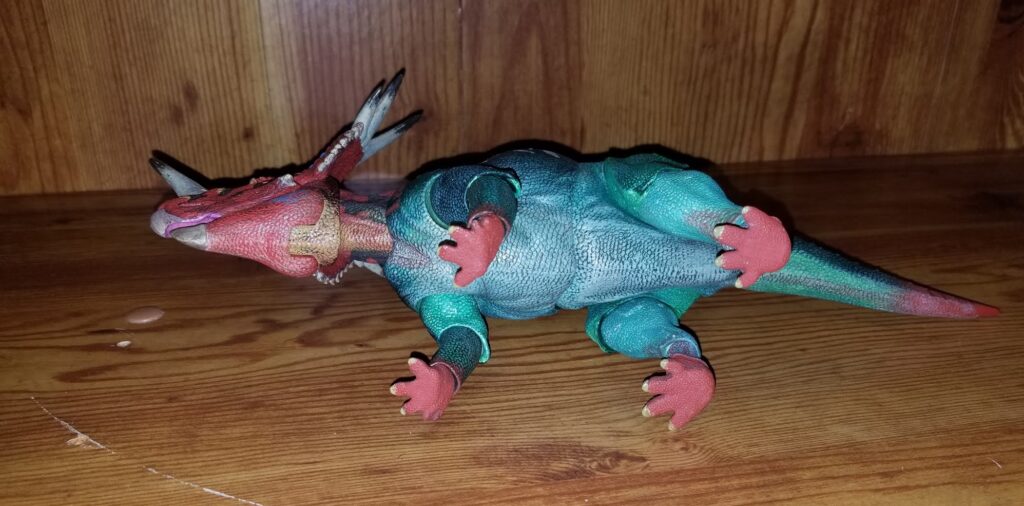
The jaw is articulated, and the tongue is too, although it is kind of hard to move around. I recommend using tweezers to rotate it around if your dinosaur’s tongue is crooked.
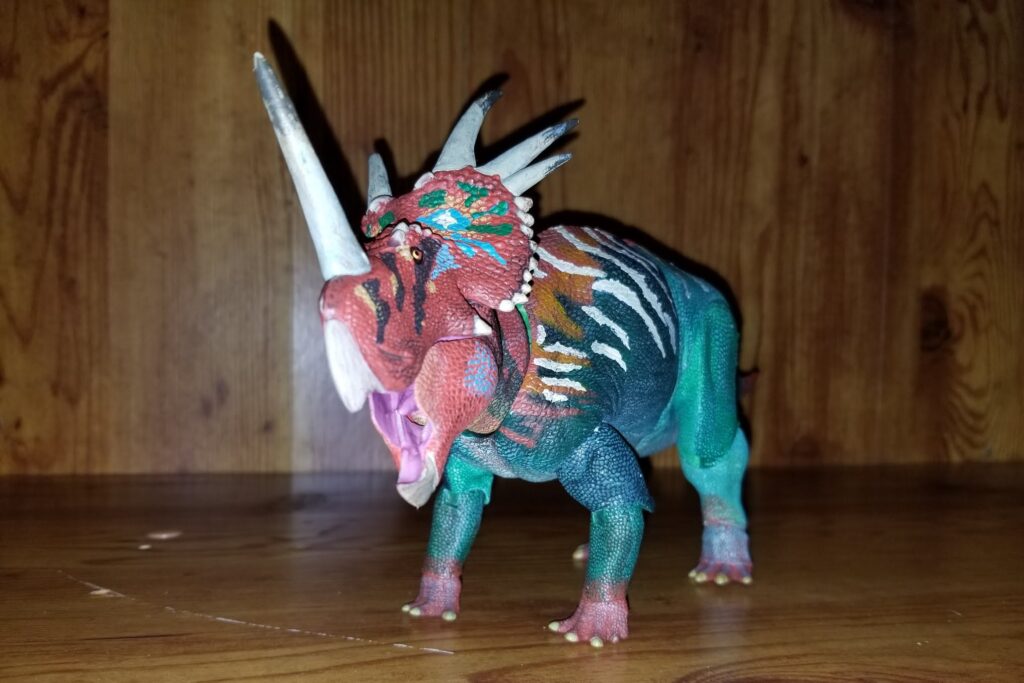
The articulation really shines on this figure. It works really well. No loose or tight joints. It can be posed to your heart’s content seamlessly. It’s a great figure for artists who want to catch a dramatic pose.
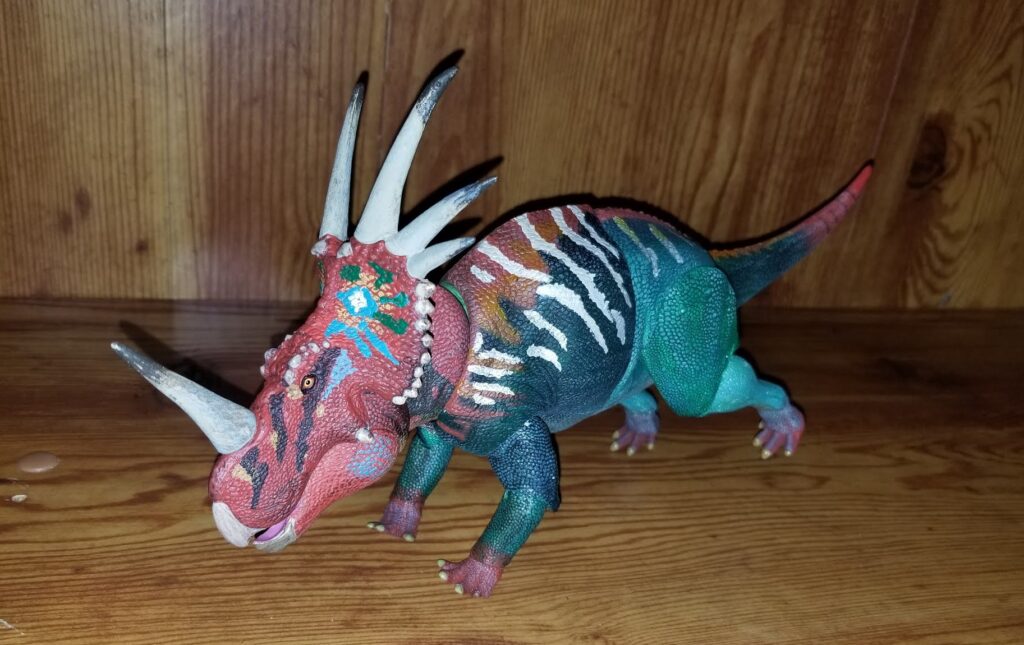
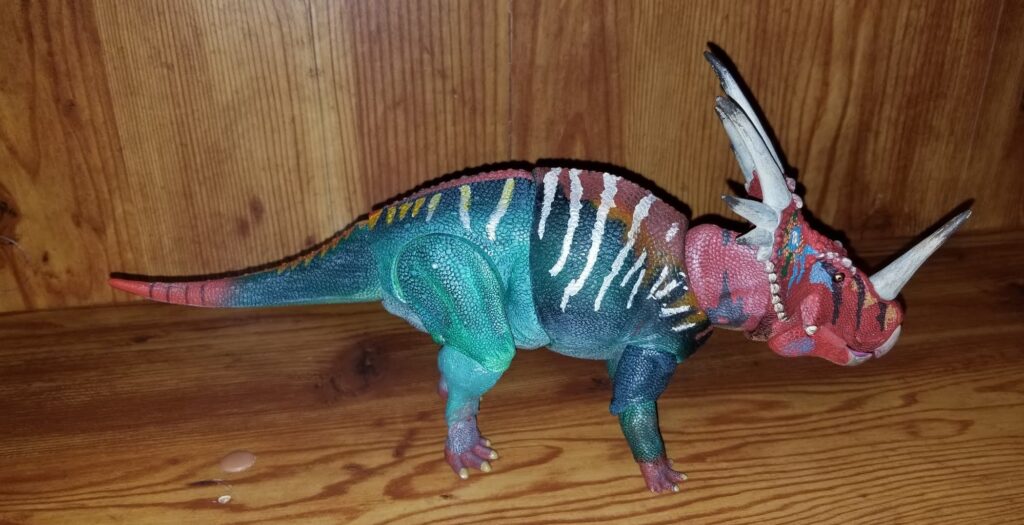
This beast of beauty measures 12 inches long from beak to tip of the tail and 6 inches tall at its horns. Being 1:18th scale, it works really well with human figures that are 3 3/4th to 4 inches tall. Depicted is Rose Tico from Star Wars, who’s a bit short for a 1:18th scale figure, but you get the idea.

Here it is with Rose again and Robin (who is in a different scale). The reason why I put Rose Tico on the pictures is because she’s roughly my height.

The more things change, the more they stay the same! Here it is compared to the similar-sized Resaurus Carnage Styracosaurus and the Tyco Styracosaurus from Dino-Riders. One thing I like about the ReSaurus version is the fact that the tail has a wire running through it so that it can be posed. I was shocked to learn that these ceratopsians do not have a wire running through their tail like the raptors did! But for some reason, I am okay with this.
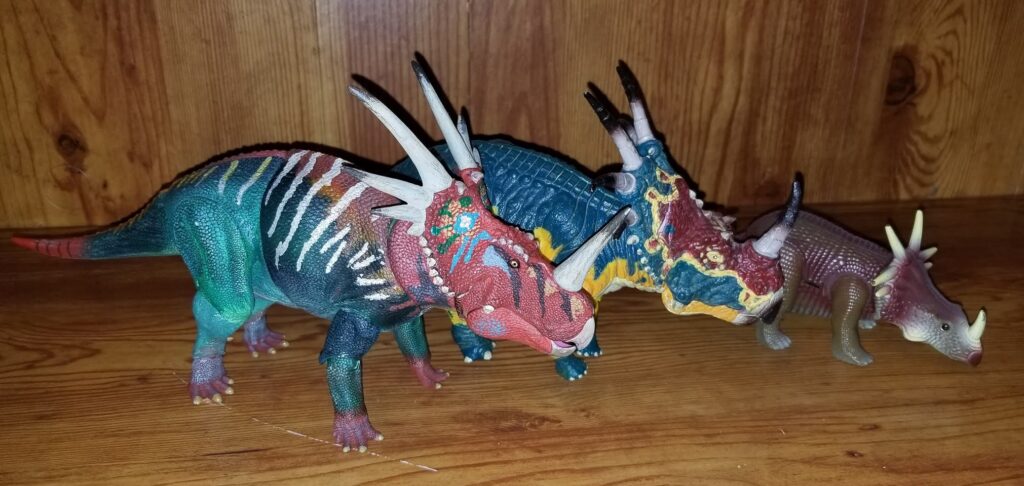
Another shot of the trio.
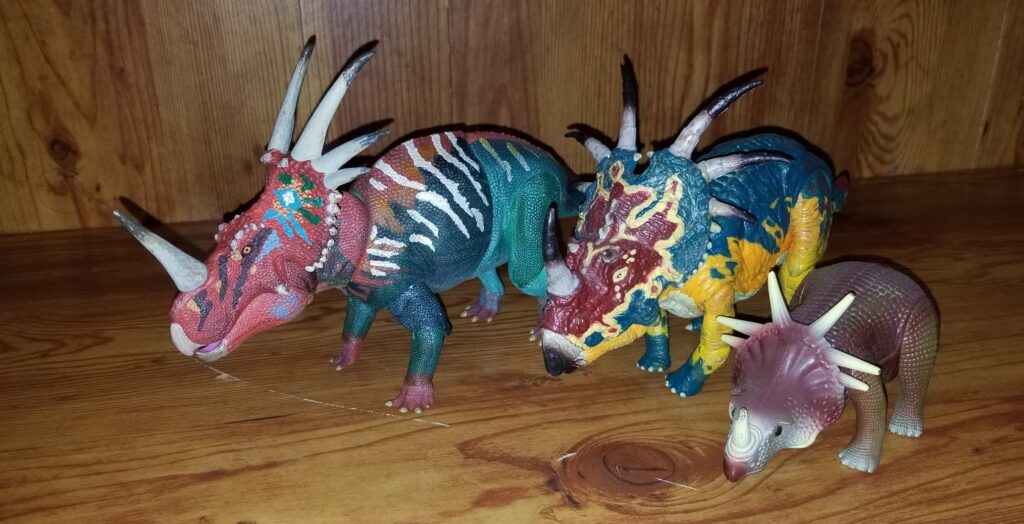
This is an amazing figure. Get this. Get it if you can. Everyone should have one.
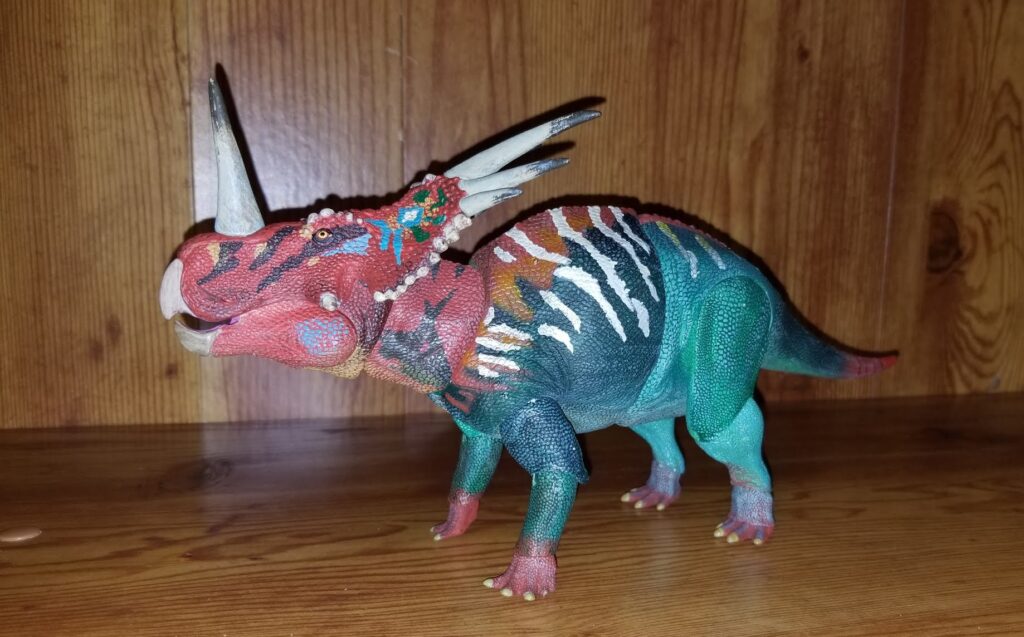
Disclaimer: links to Ebay and Amazon on the DinoToyBlog are affiliate links, so we make a small commission if you use them. Thanks for supporting us!




I like the sculpt but the final paint job is odd. Why is the front half a darker green and back half light green. Looks like they were done at two different sites. For something this expensive, the color transition should be more seamless.
I thought the BOTM Raptor series was fantastic, and was really looking forward to the Ceratopsians. I was even on board with the proposed colour schemes, but something has bothered me about the final paint jobs of this series, and I haven’t been able to put my finger on the issue until now…
I think that from a production standpoint, these figures suffer heavily from a lack of washes &/or weathering to bring out the finer details of the sculpts. Without it, the paint job looks like just that – a paint job.
A dark wash would go a long way toward muting the bright colours slightly for a more natural look and bringing out the best of these amazing sculpts.
It’s a shame, as with a little more time and care, these could have rivalled the likes of Nanmu, PNSO & Rebor in regards to aesthetic finesse. As they are, I just don’t feel that they are the best figures they could be…
Great to see colorful ceratopsians for a change! I love all the vibrant colors.
Honestly the colors are very beautiful and are part of the creative and artistic philosophy of BoTM sincerely it is a very beautiful styracosaurus that contrasts equally and even in superior genius with its Collecta counterpart. I would like to have all the BoTM figures, especially the ceratopsids. They are very pretty figures.
I find this very pleasing aesthetically. I have a large collection and there is space in it for both sober colour schemes and jewel-like brilliant rainbows. Depending on my mood, both bring me great pleasure. And at the moment in the depths of winter and a raging pandemic, I can appreciate the joie de vivre bestowed by some bright colours.
I really like this colour scheme and I think it’s perfectly plausible.
This is one of the few BotM Ceratopsians I won’t be getting, simply because i’m quite happy with my Collecta Deluxe one and they are roughly of similar size (although the BotM is probably noticeably larger).
I’ve harped on the colours in two previous BotM Ceratopsian reviews and this will be my last harp. Based on a real animal or not, it looks ridiculous, in my opinion. I hope lots of people like it, however, because I want these 1/18 scale BotM dinosaurs to be popular, as i’m hoping for many more series after the tyrannosaur series (hadrosaurs, stegosaurs and on and on).
However, I think they would be just as popular with more realistic colours, rather than these technicolour dreamcoat ones.
How are they unrealistic? Because they don’t look like elephants? Elephants are colour blind, as are their predators, they gain no benefit from bright colours.
Ceratopsians however had good colour vision, as did all of their predators. Bright colours would actively benefit them both to aid in communication and to discourage predators from attacking them.
If there is anything unrealistic, it’s the statistical odds of the colours lining up with a modern lizard. But the bright colours and hard contrasting patterns is not only plausible but actively more realistic than generic bland earth tones.
For animals to have colours on their body, they have to consume the pigments in their diet. Large animals like dinosaurs would have to ingest unbelievable amounts of pigment in order to be so brightly coloured.
I have no doubt that most if not all dinosaurs would have had flashes of colour on their body, most likely around the head area, I do not believe any of them, except maybe the tiniest, would have had jazzy colouration overall.
Modern day large mammals are not a good analogue for dinosaurs because, as you pointed out, they are colour blind. So there is no reason for them to develop colours.
The only real living analogues for dinosaurs are large reptiles and birds like crocodiles/alligators, komodo dragons and large ground birds like ostriches, emus and cassowaries. None of which are brightly coloured. In fact only the cassowary’s head area has any colour at all.
I firmly believe that dinosaurs would have been shades of green, brown or olive, and maybe some grey, with flashes of colour here and there…..but not overall. But that’s simply how I see things.
The only class of pigments used frequently by animals that they cannot synthesize is carotenoids. Hemoglobin can also be used as a pigment, and there are various other red pigments that animals can make themselves. Yellows are readily available in the form of pheomelanins. Blues are usually structural so in principle don’t require any energy to maintain once initial development is complete.
Crocodiles suffer from the same problem as mammals in terms of color discrimination–they’re effectively dichromats, in contrast to other sauropsid lineages. As you point out, cassowaries (all 3 species!) are quite colorful, although not over their whole body. Emus also have a pretty restricted patch of color.
But there’s another analogue of interest. Primates are the largest mammal lineage to re-evolve full-color vision, and while many of them are still somewhere between yellow, gray, brown, and black, there are some (mandrills, hamadryas baboons, many guenon species) that are quite colorful. Whenever a sensory modality becomes available to a lineage, some members of that lineage will coopt it for some kind of sexual or other social signaling. I don’t see any reason why dinosaurs would have been any different, and given the extremely rapid diversification of ceratopsids in the last 15 million years of the Cretaceous, I’d say they were probably more prone to extravagant sexually selected characteristics than most. Of all dinosaur lineages, to me they seem like the ones most likely to have been colorful.
Very interesting response.
One aspect of colouration that hasn’t been mentioned yet is camouflage. It’s not useful to be brightly coloured if you are a prey animal. It’s also not useful if you are a predator. Being a walking neon sign really draws attention to yourself and that is not a good thing if you are wanting to avoid being eaten or wanting to do the eating. Dull colours that blend in to the horizon or environment are more useful and would probably be selected for in most every species. In nature it is the small animals that tend to be brightly coloured and that is because they can easily hide in the environment (in foliage or burrows) to avoid being seen. Large animals don’t have that ability.
The example of primates you gave supports my view, I think, in that those primates with colour, like Mandrills, have it localized, to the face and rump. They are not red and blue all over. And that’s how I feel that it would have been on most dinosaurs. Dull colours with flashes of bright colouration, most likely around the head area and quite possibly confined to one of the sexes.
To your point about ceratopsids diversity……I was under the impression that the wide diversity of ceratopsian headgear shape and style (frills & horns) was the expression of that diversity. Each set up was unique and provided sufficient species recognition. I can see one sex of each species having coloured patches, again probably around the head, but I can’t see them having much more than that.
Until I finish my time machine, we probably won’t ever know about dinosaur colouration for certain, so everyone just has to go with their gut + the available science in deciding for themselves how brightly coloured dinosaurs were, or were not.
Camouflage is useless for an animal over a certain size.
Large birds and reptiles are still small enough to hide relatively easily, and are interacting primarily with colourblind mammals as their most common prey and predators alike. They aren’t going to see much advantage to having bright colours, while animals whose predators do see in colour can use their bright colours to discourage attacks.
Reptiles whose primary predators are birds and other reptiles tend to be brighter in colour with sharp contrasting patterns like stripes. While reptiles whose primary predators are mammals tend to be dull in colour.
I’m not convinced by this. I think most if not all dinosaurs could benefit from being camouflaged, there would always be plants that grow bigger than any dinosaur. Plus, being easily seen can attract unwanted attention, a prey dinosaur could be tired out from repeated attacks due to being seen even from far away, while a predator could be tired out from prey repeatedly moving away from it due to being seen even from far away.
Bright colours being used to discourage attacks is only used by poisonous or venomous species as far as I’m aware. I don’t see how being brightly coloured would make a ceratopsid discourage attacks.
All the above being said, I’m not against colourful dinosaur restorations, I tend to like them too. I think it’s very possible many dinosaur species were very colourful as sexual selection might have made that prevail over more dull colourations that could have been used for camouflage.
Regarding the figure of this review, I very much like the Styracosaurus’s sculpt. The colouration just doesn’t work for me though. I am eagerly waiting for the Cyberzoic Styracosaurus to be revealed as I’m hopeful its duller colouration will be one I like. If so that will be a Styracosaurus I’ll be very happy to have!
I forgot one thing, I’m aware that warning colouration can occur in non-venomous/non-poisonous species, but only when the species is mimicing a venomous species, e.g. a milk snake mimicing a coral snake or a hoverfly mimicing a wasp. I doubt ceratopsids would mimic a venomous species.